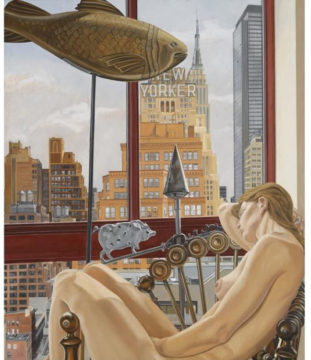Robert Storr at Art in America:
 FROM THE OUTSET, Pearlstein has occupied an anomalous position within his generation, for he has been not only the most uncompromising exponent of an unpopular style but its most visible and possibly most successful practitioner. In large measure, Pearlstein owes his special status among fellow Realists and within the art world generally to his gift for ideas and advocacy. It was more by force of argument than by example that he was able in the early 1960s to place a supposedly marginal concern—painting the figure from life—somewhere near the center of critical debate, and to link his cause to that of other artists, many of them abstractionists, who were faced with the task of sorting out the debris left by the first wave of Abstract Expressionism.
FROM THE OUTSET, Pearlstein has occupied an anomalous position within his generation, for he has been not only the most uncompromising exponent of an unpopular style but its most visible and possibly most successful practitioner. In large measure, Pearlstein owes his special status among fellow Realists and within the art world generally to his gift for ideas and advocacy. It was more by force of argument than by example that he was able in the early 1960s to place a supposedly marginal concern—painting the figure from life—somewhere near the center of critical debate, and to link his cause to that of other artists, many of them abstractionists, who were faced with the task of sorting out the debris left by the first wave of Abstract Expressionism.
Pearlstein understood that if realist art was to equal the conviction and power of abstract painting and avoid a permanent ghetto identity, it had somehow to find common ground with the most energetic work of other artists battling against “mainstream” dogma. He found that common ground by redefining the dialectic of modernism as taking place not primarily between representation and abstraction but between a rigorous, nonnarrative formalism and a too easily learned romanticism.
more here.
